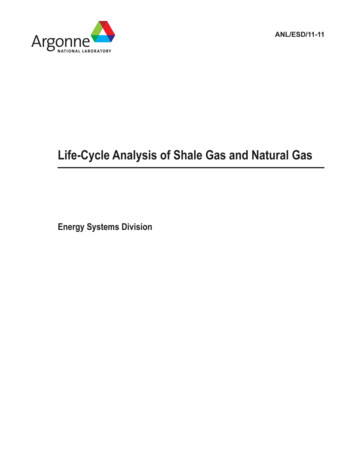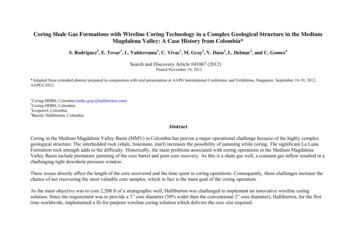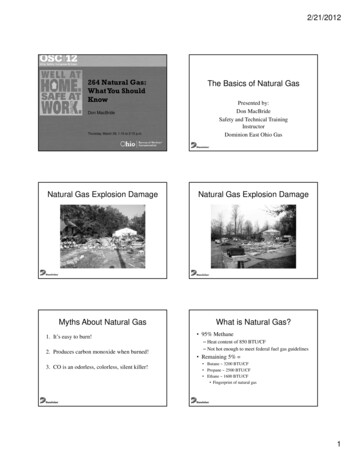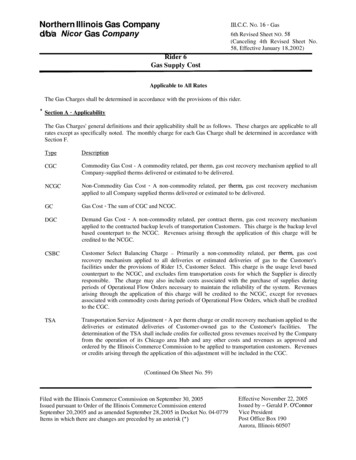
Transcription
WHERE THE SHALE GASREVOLUTION CAME FROMGOVERNMENT’S ROLE IN THE DEVELOPMENT OF HYDRAULIC FRACTURING IN SHALEAlex Trembath, Jesse Jenkins, Ted Nordhaus, and Michael ShellenbergerBreakthrough Institute Energy & Climate Programhttp://thebreakthrough.org/energy.shtmlMAY 2012
MAY 2012!INTRODUCTION"America is in the midst of a natural gas boom, fueled principally by the development of technologiesenabling the extraction of large gas reserves trapped in shale formations. Shales now produce over 25percent of domestic natural gas resources, up from 2 percent in 2001. 1 The shale boom has also pushednatural gas’s contribution to America’s electricity generation portfolio from 20 percent to nearly 30percent in the last few years alone. 2 Natural gas resources in shale, once thought to be unrecoverable anduntil this past decade prohibitively expensive to extract on a full commercial scale, are now accessible andabundant. The shale boom has expanded domesticenergy production, pushed down wholesale electricityprices to record lows, and accelerated the retirement ofAmerica’s aging coal plant fleet, significantly improvingpublic health.3 These advances were made possible bytechnological innovations resulting from a sustainedpartnership between the gas industry and the AmericanPhoto credit: Travel Afficionadofederal government.In a series of investigations and interviews with historians, gas industry executives, engineers, and federalresearchers, the Breakthrough Institute uncovered the historical role of the federal government in thedevelopment of cost-effective shale gas extraction technologies.4 We consistently found that innovationand progress in the development of hydraulic fracturing and other key gas recovery technologies arosefrom public-private research and commercialization efforts. From basic science to applied R&D totechnological demonstration to tax policy support and cost-sharing partnerships with private industry,federal programs proved essential to gas industry engineers in figuring out how to map, drill, and recovershale gas – and, most importantly, how to do it cost effectively.In summary, federal investments and involvement in the development of shale gas extraction technologiesspanned three decades and were comprised of: The Eastern Gas Shales Project, a series of public-private shale drilling demonstration projects inthe 1970s; Collaboration with the Gas Research Institute (GRI), an industry research consortia that receivedpartial funding and R&D oversight from the Federal Energy Regulatory Committee (FERC);WHERE THE SHALE GAS REVOLUTION CAME FROM
MAY 2012 Early shale fracturing and directional drilling technologies developed by the Energy Research &Development Administration (later the Department of Energy), the Bureau of Mines, and theMorgantown Energy Research Center (later the National Energy Technology Laboratory); The Section 29 production tax credit for unconventional gas, in effect from 1980-2002; Public subsidization and cost-sharing for demonstration projects, including the first successful multifracture horizontal drilling play in Wayne County, West Virginia in 1986, and Mitchell Energy’s firsthorizontal well in the Texas Barnett shale in 1991; Three-dimensional microseismic imaging, a geologic mapping technology developed forapplications in coal mines by Sandia National Laboratories.These federal investments, coordinated in close concert with gas industry representatives, were predicatedupon a single mission: the commercialization of shale gas extraction technology. As a result of theseefforts carried out over the course of 30 years, shale gas went from inaccessible deposits locked inunfamiliar geologic formations to the fastest growing contributor to the nation’s energy portfolio.Shale Gas Developme n t i n t h e U n i t e d S t a t e s: A Ti m e l i n e1821: Natural gas is first extractedfrom shale in Fredonia, NY.18201970s: Domestic gas production on thedecline; Morgantown Energy ResearchCenter (MERC) initiates the Eastern GasShales Project.19501947: Hydraulic fracturing firstused to extract natural gas fromlimestone.1980: Congress creates Section 29production tax credit for unconventionalgas (lasts until 2002).1980198519701976: Two MERC engineerspatent early technique fordirectional drilling in shale.1991: GRI subsidizes Mitchell Energy’sfirst successful horizontal well in the TexasBarnett shale.19901986: First successful multifracture horizontal well drilledby joint DOE-private venture inWayne County, West Virginia.199519801977: DOE successfully demonstratesmassive hydraulic fracturing in shale(MHF).2000s: Natural gas generation growsfaster than any other energy source; shalegas boom pushes prices to record lows.200020051998: Mitchell Energy engineersachieve commercial shale gasextraction.WHERE THE SHALE GAS REVOLUTION CAME FROM
MAY 2012!THE ROLE OF THE GOVERNMENTWHERE THE SHALE GAS REVOLUTION CAME FROM"
MAY 2012!HISTORY OF THE SHALE"REVOLUTIONB e f o re t h e R e vo l u t i o nNatural gas was first extracted from shale in Fredonia, New York in the 1820s, several yearsbefore the breakthrough oil discoveries at wells in Titusville, New York.5 But shale gas usage waslimited to early and small-scale operations – it would not play a significant role in America’senergy portfolio for another century and a half.Today, shale gas is extracted via a process called hydraulic fracturing.6 While fracturing has beenused for natural gas extraction since the 1940s, 7 it wasn’t until the 1970s and 1980s that efforts toapply the technique in shale deposits were developed. Shale formations have a peculiar geologyof high porosity but low permeability. Unlike limestone or sandstone, shale’s characteristics makeit particularly difficult to fracture predictably. Conventional rotor drill bits and poor imagingtechnologies made reliable fracture tracking practically impossible. Significant basic research wasneeded to understand shale geology before technical applications could be fully commercializedto capture the natural gas resources locked inside.As such, conventional fracturing techniques proved unsuccessful in shale. Engineers had neitherthe technology nor the knowledge base to cost effectively map shale expanses, drill horizontally inthe formations, initiate fractures that were productive and predictable, and recover the gasresources locked in the formations. It is not surprising then that, while geologists had known sincethe 1820s that there were significant gas deposits in shale, 8 we didn’t start to capture theseresources until the late 20th century. Indeed, before the development of shale fracturingtechnologies, gas companies would drill past shale to get to sandstone deposits underneath.9What is Hydr aulic Fracturing?Hydraulic fracturing, or “fracking,” is a resource recovery technique used to extract natural gasstored in geologic formations. Used in limestone and sandstone gas deposits since the 1940s and inshales since the 1970s, fracking involves drilling through permeable rock expansions and pumping ina combination of water, sand, chemical lubricants, and “propants” to keep the induced fracturesopen for gas recovery.WHERE THE SHALE GAS REVOLUTION CAME FROM
MAY 2012A n Industr y I n D e cl i n e F i n d s a N e w P a rt n e rConventional natural gas production in the United States began to decline in the early 1970s. 10In a decade when both the Ford and Carter administrations were prioritizing fossil energy R&Dduring the oil crises, the natural gas industry reachedout to federal research agencies for help in bufferingdomestic gas resource potential.11 The industry andfederal researchers had their eyes on unconventionalresource bases that stood out of reach fromDan Steward, f orm erMi t chel l Energy VicePresi dentcontemporary drilling technologies, including coalbedmethane deposits, “tight sands” natural gas, and shalegas.12While Jimmy Carter is often pointed to as the presidentwho initiated the energy push in response to the oilcrises of the early seventies, it was Republican PresidentGerald Ford whose administration began a concertedfederal effort to seek unconventional natural gas inresponse to shortages. In 1976, the Morgantown EnergyResearch Center (MERC, now the National EnergyTechnology Laboratory) and the Bureau of Mines(BOM) initiated the Eastern Gas Shales Project, whichestablished a series of demonstration partnerships withuniversities and private gas companies in Pennsylvaniaand West Virginia. That same year, two MERCengineers - Joseph Pasini III and William K. Overby, Jr.– patented an early directional shale drilling technique“In the seventies we started running out of gas,and that’s when the DOE started looking formore. The DOE’s [Eastern Gas Shales Project]determined there was a hell of a lot of gas inshales.“We got the DOE and the GRI [Gas ResearchInstitute] involved in the Barnett in the early1990s. Mitchell hadn’t wanted to get theminvolved because we were trying to understandit and didn’t want competition for the Barnettuntil we had a handle on what we were doing.By the early 1990s, we had a good position,acceptable but lacking a knowledge base, andthen Mitchell said ‘Okay, I’m open to bringingin DOE and GRI’ in 1991.“Mitchell was selling his gas a dollar and aquarter over the spot price. Mitchell had themoney to invest in R&D. So you could say thatthose pricing scenarios, and the [Section 29] taxcredit, created the possibility for shale gas.“DOE started it, and other people took the balland ran with it. You cannot diminish DOE’sinvolvement.”For the complete interview with Dan Steward, go w with dan steward for.shtmlthat allowed operators to span larger radial expanses of shale deposits. These breakthroughswould later lead to horizontal well drilling in shale, which ultimately proved a much more costeffective method for recovering large stores of natural gas.13A key early innovation came from a partnership between General Electric and the EnergyResearch and Development Administration (ERDA, a precursor to DOE) to develop advancedWHERE THE SHALE GAS REVOLUTION CAME FROM
MAY 2012drill bits. Diamond-studded bits proved more effective at drilling through shale than conventionaltools. ERDA originally sought to use the diamond technology for drilling in hot dry rocks for theagency’s geothermal energy program, but the more successful application came when ERDAdeveloped drill bits for shale drilling in collaboration with the gas industry.14Federal researchers and engineers often worked veryTer r y Engelder, Pennclosely with natural gas companies in theState Universitydevelopment and refinement of shale gas recoveryProfessortools and techniques. The National Labs, including“[The Eastern Gas Shales Project] helpedexpand the limits of gas shales production andincreased understanding of productionmechanisms. It is one of the great examples ofvalue-added work led by the DOE.“The government got it really right. In terms ofa symbol of effective public-private venture, it’sshale gas.“The amount of money spent on R&D rightnow is sadly lacking. This [shale gas research]really took 20 to 30 to 40 years before it reallyworked. In terms of solar, it’s going to be thesame.”For the complete interview with Terry Engelder, go tohttp://thebreakthrough.org/blog/2012/01/terry engelder on the federal.shtml.Sandia, Los Alamos, and Lawrence Livermore,contributed modeling, monitoring, and evaluation tothe MERC-contracted demonstration projects. In1979, the public-private efforts to drive shale gas andcoalbed methane to market were formalized in thenew Department of Energy’s Commercialization Planfor Recovery of Natural Gas from UnconventionalSources.15Because of shale’s peculiar geology, new imagingtechnology was necessary to map shale deposits.Three-dimensional microseismic imaging, atechnology developed by Sandia National Laboratories for work in coal mines, wasserendipitously imported for application in shale gas drilling.16 The new seismic tools andmapping software allowed drillers to visualize the shale formations and locate the naturalfractures and unevenly-distributed gas deposits. Without microseismic, shale drillers were blind,and it is unlikely that either public or private fracturing R&D efforts could have proved fruitfulwithout the critical imaging technology. 17In 1980, Congress passed the Windfall Profits Tax Act, which among other things created theSection 29 production tax credit for unconventional gas, providing an incentive of 0.50 perthousand cubic feet (Mcf) of natural gas produced from unconventional resources.18 The taxcredit expired in 2002, after Mitchell Energy had achieved commercial production from theWHERE THE SHALE GAS REVOLUTION CAME FROM
MAY 2012Barnett shale. Production of unconventional gas nearly quadrupled over this period, with theproduction tax credit vital to the growth and maturation of this advanced energy industry.19Federal support proved essential in the early goings of the shale gas revolution. As Fred Julander,head of Julander Energy and member of the NationalPetroleum Council, notes, "The Department of EnergyAlex Crawley, form erwas there with research funding when no one else wasAssociate D ire ctor forinterested and today we are all reaping the benefits.Research, NationalPetroleum TechnologyEarly DOE R&D in tight gas sands, gas shales, andOfficecoalbed methane helped to catalyze the development of“After ERDA was formed the emphasis was on‘what can we do to help energy production inthis country’ during the embargo.“All that technology coming together - massivehydraulic fracturing, diamond-studded drill bits,3D seismic imaging, directional drilling - itwasn’t until the 1980s that it becameeconomical enough to repeat it. [Before that,]they were drilling through shale to get tosandstone reservoirs.“As far as shale is concerned, I don’t know thatindustry would ever have taken a look at itwithout the federal program, because it didn’tlook like it had the porosity to be reachable.Government’s not going to step in and developanything all the way through, but working withindustry you have a different set of eyes. If youkeep an open mind the government can becomea real catalyst.”For the complete interview with Alex Crawley, go w with alex crawley former program director for the energy research and development administrationtechnologies that we [in the industry] are applyingtoday."20M i t ch e l l E n e rg y C ra cks t h e B a rn e t tMost of the early R&D and demonstration work wasdone in the Devonian and Marcellus shales, large shaleformations occupying portions of Pennsylvania, Ohio,Kentucky, and West Virginia.21 But the finalbreakthroughs would come in the Barnett shale innortheast Texas. George Mitchell, a veteran of theTexas natural gas industry, wanted to apply thetechnologies developed in the Eastern United States tothe Barnett.22 He and other industry representativesspent much of the 1980s advocating for DOE fossilenergy research, even as Congress attempted to zero out R&D budgets as the nation enjoyed lowoil prices.23 In the mean time, Mitchell Energy’s engineers and geologists performed considerablein-house R&D, working to scale hydraulic fracturing for commercial application in shale gasrecovery.24In 1986, a DOE/private venture first demonstrated a multi-stage horizontal fracture in theDevonian shale.25 Commercial-scale hydraulic fracture recovery, however, would not come untilWHERE THE SHALE GAS REVOLUTION CAME FROM
MAY 2012after Mitchell Energy’s team had finished work on refining the drilling processes and inputs.Here, again, the federal government would step in to aid the private sector.In addition to innovating on top of platform technologies like MHF and directional drilling thatwere originally developed by the ERDA, MERC, DOE, and other federal agencies, MitchellEnergy benefitted from a direct and sustained partnership with the federal government. In the1980s Mitchell relied on DOE mapping techniques and research to understand the complexgeology of tight shale formations. In 1991, Mitchell partnered with DOE and GRI to developtools that would effectively fracture formations in the Barnett shale, which now produces over 6percent of all domestic natural gas.26 GRI's microseismic imaging data proved particularly usefulthroughout the 1990s when Mitchell Energy would make the final key innovations credited with“cracking the Barnett.”Although unconventional gas production had been growing since the early 1980s, hydraulicfracturing technology had not been perfected or scaled to the point where full commercialdeployment was competitive without subsidy. Shale gas production relied on the Section 29production tax credit and on developers like Mitchell Energy charging a premium for gasresources. Mitchell Energy invested revenues in in-house R&D throughout the 1980s and1990s.27 Having successfully demonstrated multi-fracture horizontal well drilling techniques inthe Barnett, engineers had to develop the optimal combination of inputs – water, sand, propants,chemical lubricants, etc. – to achieve maximum gas recovery at the lowest cost possible. In 1998,Mitchell Energy engineers, led by Nick Steinsberger, applied an innovative drilling techniquecalled ‘slick water fracturing’ (or ‘light sand fracking’) that brought fracture job costs down toaround 100,000, compared to between 250,000 and 300,000 for MHF projects.28 This iswidely considered a milestone that pushed shale gas into full commercial competitiveness.Mitchell Energy was bought by Devon Energy in 2002 for 3.5 billion, the same year that theSection 29 production tax credit was allowed to expire.29 The rest, as they say, is history.WHERE THE SHALE GAS REVOLUTION CAME FROM
MAY 2012!F R E Q U E N T LY A S K E D Q U E S T I O N S"If hydr aulic frac turing w as around i n t h e 1 9 4 0 s, w h y d i d t h e g o ve rn m e n t st a rtinvesting in it in the 1970s?Hydraulic fracturing was used in limestone and sandstone for decades before the onset of theshale revolution. Before the shale revolution, it was common knowledge that shale formationsspread throughout the country contained plentiful stores of natural gas. But it wasn’t until the1970s, with the American gas industry suffering from declining production rates, that there wereany significant attempts to apply the technology in shales. Early attempts proved challenging, andfull-scale commercial shale fracturing would only be achieved after decades of public and privateinvestments in new shale gas recovery technologies, including drilling, fracturing, and advancedmapping techniques.Was this s i m pl y a ca s e w he re t he government introduced early iterations of thetechnology that w ere then perfecte d b y p ri va t e se ct o r i n n o va t o rs?While private gas companies, particularly Mitchell Energy, did provide substantial in-house R&Dto the shale gas commercialization effort, federal programs were involved along every phase ofthe innovation pipeline. From early R&D (diamond-studded drill bits, microseismic imaging,directional drilling) to cost-sharing on demonstration projects (the Eastern Gas Shales Project, thesubsidization of Mitchell Energy’s first horizontal drill in the Barnett) to tax policy support for apre-commercial industry (the 1980-2002 Section 29 production tax credit for unconventional gasresources), federal agencies and policies acted over 25 years to maximize the effect of shale gasresearch and commercialization.W ho’s to say that the private s ec t o r w o u l d n ’ t h a ve d e ve l o p e d t h e t o o l s t h e y n e ed e dfaster and at low er cost than fede ra l re se a rch e rs?It’s clear that government investment and research worked to drive innovations and cost declinesin shale gas extraction technologies, but one could construct a counterfactual argument that theprivate sector would have achieved these gains without any public support. But history puts thiscounterfactual to the test: there are plenty of countries with sizable shale deposits but withoutAmerica’s strong public innovation system – including Russia, China, Poland, South Africa,WHERE THE SHALE GAS REVOLUTION CAME FROM
MAY 2012Britain, and others – whose active oil and gas industries did not make congruent investments inshale fracturing technologies. It was the United States that first cracked the shale gas challengethrough decades of research and commercialization; shale fracturing operations in othercountries are only now getting off the ground.Technologies like diamond-studded drill bits and microseismic imaging were developed by federalagencies for non-shale applications, demonstrating the clear and present value of publicly-fundedbasic research. The initial shale fracturing research and demonstration projects were initiated bythe federal Morgantown Energy Research Center, and the bulk of private sector R&D took placewithin the Gas Research Institute, a gas industry research consortia funded partially by a FERCapproved surcharge on natural gas pipelines whose research budgets were subject to federalapproval.Because private companies have difficulty monetizing and capturing all the benefits of energytechnology research, it is consistently the case that federal coordination and investment isrequired to drive high-level technological innovation in the energy sector. As documented in theBreakthrough Institute’s 2010 report “Where Good Technologies Come From,” the Americanfederal government has historically played a leading role in the development a broad range ofinnovative technologies, including microchips, jet turbines, nuclear power reactors, and theInternet.30The gas industry itself has spoken on behalf of federal research efforts. “The DOE started it,and other people took the ball and ran with it,” said Mitchell Energy’s former Vice PresidentDan Steward. “You cannot diminish DOE’s involvement.”WHERE THE SHALE GAS REVOLUTION CAME FROM
MAY 2012!NOTES AND January"23,"2012,"h 2,"h p://www.eia.gov/forecasts/steo/pdf/steo il"10,"2012,"h p://thebreakthrough.org/blog/2012/04/have us emissions og,"March"12,"2012,"h p://thebreakthrough.org/blog/2012/03/shale gas fracking history 1,"h ccessed"May"14,"2012,"h p://en.wikipedia.org/wiki/Hydraulic December"2010,"h 2."h p://www.eia.gov/dnav/ng/ng prod sum dcu NUS gy"Technology"Center"(MERC),"April"18h20,"1979,"h y"Technology"Laboratory"(NETL),"h ons/brochures/Shale Gas March h p://www.netl.doe.gov/newsroom/100yr/NETLhA Century of in&Science&and&Technology,"Fall"2006,"h ch"1978"to"2000,""Commi ences,"Na5onal"Research"Council,"2001,"h p://www.nap.edu/openbook.php?isbn 0309074487.WHERE THE SHALE GAS REVOLUTION CAME FROM
MAY ,"h p://media.godashboard.com/g5/1ResearchCap/1 5EandP/1 5 1 r,"1988,"h p://www.fischerhtropsch.org/DOE/ conf proc/MISC/Confh89 6103/doe metch89 vieve"Benne akthrough"Ins5tute,"December"2010,"h 0American%20Innova5on%20report.pdf.WHERE THE SHALE GAS REVOLUTION CAME FROM
before the breakthrough oil discoveries at wells in Titusville, New York.5 But shale gas usage was limited to early and small-scale operations - it would not play a significant role in America's energy portfolio for another century and a half. Today, shale gas is extracted via a process called hydraulic fracturing.6 While fracturing has been










